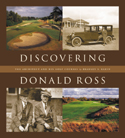|
 Bradley
S. Klein would seem to be uniquely qualified to write a biography of
Donald Ross. As an
architecture editor at industry bible Golfweek, he possesses
the necessary background to write about one of the most famous golf
architects in history. Should
anyone doubt his technical knowledge of day-to-day golf course
maintenance, he can point to his tenure as founding editor of Superintendent
News. His Ph. D. in
Political Science puts to rest any concerns about his methodology
and thoroughness. Klein holds memberships at Royal Dornoch, the
course where Donald Ross learnt the game of golf, and at Wampanaog,
the home of the Donald Ross Society. Bradley
S. Klein would seem to be uniquely qualified to write a biography of
Donald Ross. As an
architecture editor at industry bible Golfweek, he possesses
the necessary background to write about one of the most famous golf
architects in history. Should
anyone doubt his technical knowledge of day-to-day golf course
maintenance, he can point to his tenure as founding editor of Superintendent
News. His Ph. D. in
Political Science puts to rest any concerns about his methodology
and thoroughness. Klein holds memberships at Royal Dornoch, the
course where Donald Ross learnt the game of golf, and at Wampanaog,
the home of the Donald Ross Society.
With
this pile of qualifications, it would have been a shame if Klein had
turned in anything less than a stellar work.
Fortunately, the book is beyond reproach.
Klein
relates in fascinating detail the life of the young Donald Ross.
Ross grew up poor, with the almost clichéd devoted mother
and hard-drinking father. His
childhood seemed to be free of excessive trauma, however, as his
mother provided a warm environment. One
of my favorite sentences from the book gives a sense of this —
Klein notes that “Always, there was soup.”
Ross’
great fortune was growing up a half mile from Royal Dornoch; one of
the oldest and finest links courses in the world.
Instead of living a forgettable life as a partner, Ross
learned about golf courses, golf equipment, golf club politics, and
the golf swing, working his way up to head professional before
eventually moving across the Atlantic to run several courses, most
notably Pinehurst. Ross served as professional at Pinehurst and
designed the ever-hanging layouts at the seven-course complex.
One of the more interesting assertions comes from Pete Dye,
who in a lively forward argues that the famous “raised” greens
of Pinehurst #2 are the result of years of top-dressing. We
also find out that the famous Pinehurst greens were oiled sand until
1935.
Klein
eventually shifts his focus from Ross’ life to his architecture,
giving a good sense how early contributions while acting as club
professional shifted in to more formal design work.
One of the great lessons of the book is how little time was
often spent at a given course, and how the degree to which a golf
course can be termed a “Ross” course varies greatly.
One
of the most impressive aspects of the book is the section at the end
in which Klein valiantly attempts to quantify the degree of Ross’
involvement at some 400 courses. Fans of Ross’ work may be shocked to find out how little
time (or indeed no time at all) he spent at some of his courses.
Klein also does a commendable job condemning unfortunate
restoration attempts and praising others.
For
me, the book becomes slightly less interesting as it moves into a
detailed discussion of Ross’ course architecture.
Perhaps it would take a true Ross fanatic or a member at one
of the courses discussed to remain fully engaged. Despite this,
there are plenty of stunning photographs, which work well with the
text to illustrate various design points. Klein
does a good job of showing how his work developed in loosely
observable phases, from “Formative Era” to “Functionalist
Phase,” but always with the utmost respect for the terrain he was
working with. Many
consider this to be the hallmark of truly great golf course
architecture. Modern artists may groan that some of the sites they must work with
necessitate a certain degree of theatrics. That complaint contains some measure of truth, but the way the
courses of classic architects have stood up, working without benefit
of modern earth-moving equipment, shows the value of the doctrine of
minimal interference.
Klein’s
writing isn’t without the odd quirk. He
has a curious fondness for the word “distaff,” and his
exploration of various branches of Scottish Presbyterianism may not
interest some readers. At
other times, this detail is a boon; Klein’s willingness to explore
issues of race, segregation in the south and its relation to
Pinehurst, and the anti-Semitism prevalent in some golf courses
deserves special mention. This
thoroughness and an obvious love for the work of Donald Ross makes
Bradley Klein’s “Discovering Donald Ross” one of the finest
golf books I have read.
The
book is published by Sleeping Bear Press.
--
McGregor Sainsbury |

